|
External trade
Merchandise exports achieved another year of strong growth in 2006. Total
exports of goods, comprising re-exports and domestic exports, grew 10.2 per cent in
real terms in 2006, after an 11.4 per cent rise in 2005. After kicking off with a rapid
growth in the first quarter of 2006, growth slowed slightly in the second quarter,
before picking up again in the third and fourth quarters. Notwithstanding the
uncertainties at the beginning of 2006, the global economic environment was largely
supportive during the year. A number of favourable factors also set in particularly
during the second half of the year. These included a notable fall-back in oil prices,
improved competitiveness as a result of a weakened US dollar, and a strengthening of
intra-regional trade. Adding to this, was the ongoing strong support from the robust
Mainland economy and its vibrant trade flows.
Within the sphere of exports, re-exports continued to be the growth driver, rising
by 10.8 per cent in real terms in 2006, following an 11.6 per cent growth in 2005,
which marked the fifth consecutive year of double-digit growth. Nevertheless, re-exports
slowed in the second quarter after their strong first quarter start, but picked
up in the second half of the year on the back of the strengthening intra-regional
trade and the further weakening of the US dollar. Domestic exports accounted for
only 5 per cent of total exports in 2006. Reflecting the volatilities during 2006,
domestic exports were lifted by a strong surge in textile and clothing exports in the
first half of the year but which then reverted to a decline mode in the second half as
the high base set in. For 2006 as a whole, domestic exports moderated to a 1.1 per
cent growth in real terms, after a 7.6 per cent growth in 2005. The year 2006 was
the third consecutive year in which domestic exports registered positive growth
(Chart 7).
| Chart 7 |
| Hong Kong's visible trade |
| (year-on-year rate of change in real terms) |
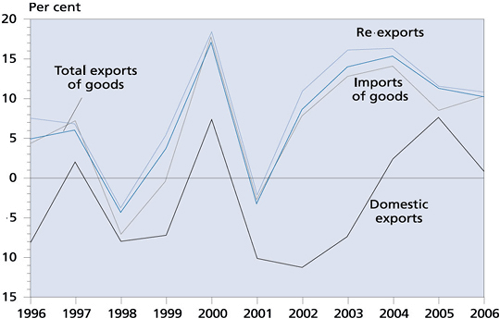 |
|
|
The Mainland continues to be a most attractive market for Hong Kong whose
exports to that market picked up further in 2006 after very robust growth in 2005.
This bright situation owes much to the Mainland's vibrant trade flows, including
strong imports spurred by its buoyant domestic demand. Renminbi's appreciation
during the year also helped increase imports into the Mainland. As a result, Hong
Kong's shipment of goods to the Mainland for processing for re-export and for
consumption continued to show robust growth.
Hong Kong's exports to countries in Asia continued to grow in 2006. This was
due partly to their economies performing generally well, aided by flourishing intra-regional
trade and the strengthening of many Asian currencies during the year. In
contrast, the slowdown in exports to Japan since the fourth quarter of 2005
continued into 2006, due mainly to the weak yen.
However, Hong Kong's exports to its conventional markets in Europe and the US
fared less well. Notwithstanding the economic upturn in EU in 2006, exports to this
market slowed rather significantly during the year, mainly because of its moderating
import demand and the lagged effect of a weaker euro in late 2005 and early 2006,
and also because of the high base effect of the surge in textile and clothing exports to
these markets in the first three quarters of 2005. Exports to the US market registered
only a small increase in 2006, likewise affected by the textiles and clothing export
surge of 2005. The increasing trend for Mainland products to be shipped directly from
Mainland ports to overseas markets was probably another contributing factor.
Imports racked up a 10.2 per cent growth in real terms in 2006, from an 8.5 per
cent increase in 2005. Import of goods intended for re-export maintained strong
growth during 2006 in tandem with the robust re-export growth. The further pick-up
in domestic demand also saw retained imports record a notable 8.4 per cent growth
in real terms in 2006, after a meagre 0.8 per cent rise in 2005. Retained imports of
capital goods surged throughout 2006, boosted by strong acquisition of
telecommunications and office equipment. Retained imports of consumer goods,
after a modest decline in 2005, also revived strongly in 2006, buoyed by bullish
economic conditions which in turn boosted consumer spending. But retained imports
of raw materials and semi-manufactures fell further.
With the increase in the value of imports of goods exceeding that of exports, the
visible trade deficit calculated on a GDP basis has grown in absolute terms from
$59.3 billion or 2.6 per cent in 2005 to $109.0 billion or 4.2 per cent of the value
of imports of goods in 2006.
Exports of services, which were on a sustained robust uptrend over the past
several years, grew further by 8.9 per cent in real terms in 2006. Exports of trade-related
services, comprising mainly offshore trade, surged at double-digit rate,
underpinned by the Mainland's vibrant trade flows. The buoyant financial markets,
boosted particularly by the growing number of IPOs and other fund-raising activities
during the year, also saw double-digit growth in exports of financial services in 2006.
Exports of travel services slowed quite noticeably in the latter part of the year
because of a fall in the number of visitors to Hong Kong, but overall they were able
to maintain growth throughout the year.
Imports of services grew by 6.4 per cent in real terms in 2006, after a 7.4 per
cent growth in 2005. Imports of financial, business and other services showed
double-digit growth in 2006, while imports of transportation services recorded solid
growth during the year. Imports of travel services reverted to a mild increase in 2006,
while growth in imports of trade-related services was moderate throughout the year
(Chart 8).
| Chart 8 |
| Hong Kong's invisible trade |
| (year-on-year rate of change in real terms) |
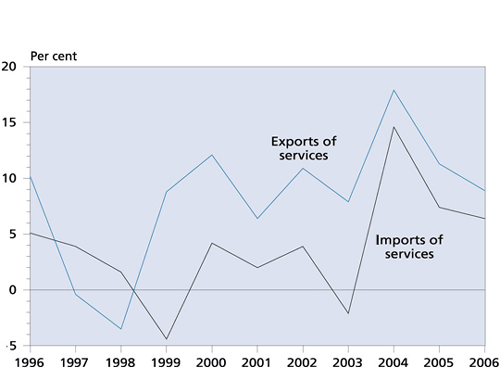 |
|
|
Boosted by the surge in exports of services, the combined visible and invisible
trade balance continued to record sizable surplus of $172.1 billion in 2006,
equivalent to 6.0 per cent of the total value of imports of goods and services,
compared to $172.2 billion and 6.7 per cent in 2005. The sizeable surplus
underscored the Hong Kong's strong external competitiveness on the one hand, and
the city's increased resilience to volatilities and external shocks on the other.
Domestic demand
Compared to trade, business on the domestic front was steadier, but an equally
important contributor to Hong Kong's economic growth in 2006. Local consumption
showed solid growth throughout the year, the labour market continued to perk up on
a broad front, and the asset markets performed. Together, these factors presented a
bullish economic picture. Reduced uncertainty over interest rates in the latter part of
the year also boosted consumer confidence. Private consumption expenditure grew
by 5.2 per cent in real terms in 2006, a remarkable jump from the 3.3 per cent of the
previous year.
Overall investment grew for the fourth year in a row, highlighted by a 7.9 per
cent growth in 2006, the fastest in six years. This was due mainly to a sustained
surge in machinery and equipment acquisition, a clear reflection of investor
confidence in the economy. However, the construction industry as a whole was
lacklustre. After a short-lived rebound in the second quarter, private sector building
and construction activity slowed again and recorded a moderate decline in the latter
half of the year. Public sector building and construction activity was also slack, due to
a fall-off in public housing works and a lack of large-scale infrastructure projects
(Chart 9).
| Chart 9 |
| Main components of domestic demand |
| (year-on-year rate of change in real terms) |
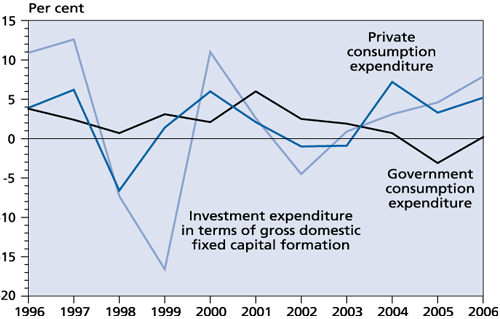 |
|
|
The Labour Market
The labour market improved on a broad front for the third consecutive year in
2006, on the back of sustained strong economic growth. The growth pattern was
broadly similar to that of the preceding two years, which was characterised by a
strong expansion in total employment, a notable decline in unemployment and a
slight rise in labour earnings. The job market continued improving throughout 2006,
reaching an all-time-high figure of 3.47 million people with jobs in the fourth quarter.
The seasonally adjusted unemployment rate fell to a near six-year low of 4.4 per cent
by the end of the year, while the number of unemployed people slipped to 153 700.
At the same time, the underemployment rate also fell, to 2.4 per cent (Chart 10).
| Chart 10 |
| Unemployment and underemployment rates |
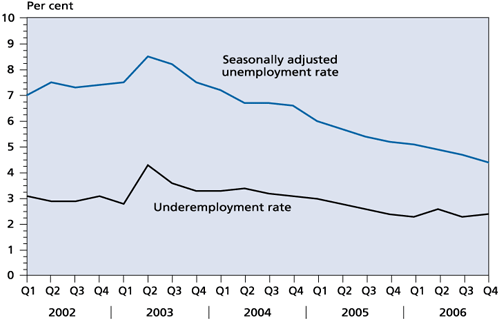 |
|
|
Employment in 2006 grew by 2.1 per cent, outpacing a 1.3 per cent increase in
labour supply. In absolute terms, total employment was up by 70 800, broadly
comparable to the average growth during the economic upturn in the early 1990s.
Figures at the end of 2006 showed that an additional 299 000 jobs had been
created since the employment slump in mid-2003, much exceeding the growth of
145 900 in the labour force (Chart 11).
While additional jobs were offered almost across-the-board, there were clearly
more employment gains for managers and administrators, service workers, shop
salespersons, workers in elementary occupations, those persons engaged in the
wholesale, retail and import/export trades, restaurants and hotels, as well as people
with upper secondary or above education.
| Chart 11 |
| Total labour force and total employment |
| (year-on-year rate of change) |
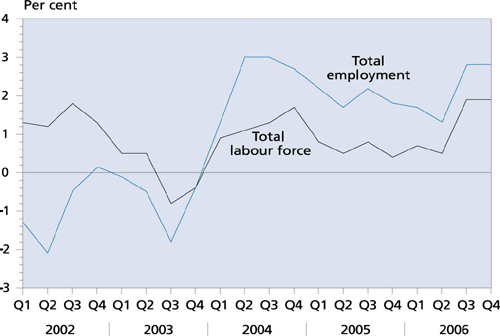 |
|
|
By comparison, job vacancies in the private sector rose by 5.7 per cent in
December 2006 over the same period in 2005. Although the growth was slower
than that seen in the preceding two years, this was partly due to the increased
take-up of jobs during 2006. When job vacancies are matched against the
unemployment figures, the overall ratio showed an increase to 25 job openings for
every 100 job seekers in December 2006, from around 20 a year earlier. While the
ratio for lower-skilled jobs rose from 16 to 20, that for higher-skilled jobs went up
from 54 to 73. There are currently more openings for higher-skilled workers, as
reflected in the 7.0 per cent increase in vacancies in the higher-skilled sector and the
4.8 per cent fall in the lower-skilled field. In addition, figures showed a significant
proportion of the vacancies occurring in 2006 was for jobs in the services sector,
especially the import and export trades, restaurants, business services and financing.
Notwithstanding a greater demand for workers, wage increases remained
moderate. Labour earnings in the private sector rose by 2.4 per cent in money terms
or 0.4 per cent in real terms in 2006 compared to a year earlier. This modest overall
movement however concealed fairly wide variations among different economic
sectors and occupations. For instance, pay rises in the finance, insurance, real estate
and business services sectors were relatively higher with employees in these fields
receiving average pay rises of 5.6 per cent in money terms, compared with the
increases for workers in the restaurant and hotels, transport, storage and
communications, and manufacturing sectors which were 2.6, 2.1 and 1.4 per cent
respectively (Chart 12).
| Chart 12 |
| Labour earnings |
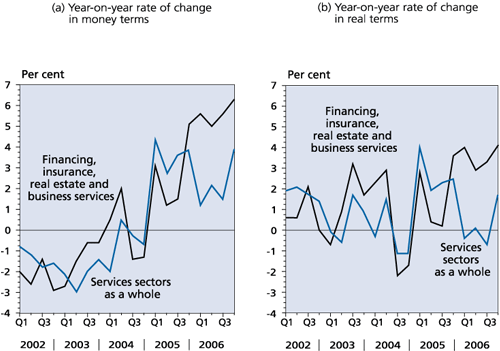 |
|
|
The Property Market
The home sales market went through a healthy consolidation in 2006, adjusting
further to the hectic situation which prevailed from mid-2003 to mid-2005. Flat
prices moved within a narrow margin in 2006, as prospective buyers became more
prudent after the earlier price surge. The uncertain interest rate outlook was also a
restraining factor, which diminished following the pause in US interest rate rises since
August. Nevertheless, market sentiment remained generally positive, as the longer-term
outlook was well underpinned by the sanguine economic outlook and the
improving employment situation. In December 2006, flat prices edged up by 4 per
cent over a year earlier. Compared with the trough in 2003, flat prices in December
2006 were 61 per cent higher, but still 46 per cent off the peak in 1997. As regards
leasing, flat rentals increased further during 2006, albeit at a steadier pace of 6 per
cent. The leasing performance was supported by the progressive improvement in user
demand alongside the economic upturn (Chart 13).
| Chart 13 |
| Prices and rentals of residential property |
| (1999=100) |
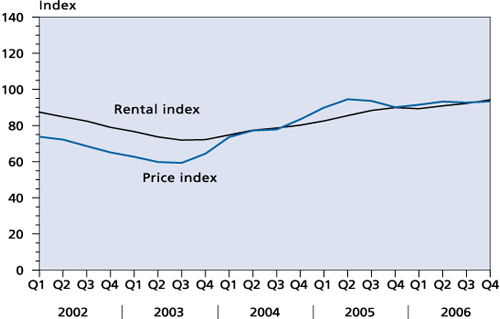 |
|
|
The non-residential property market fared rather well in 2006, with the office
segment performing strongly. Rents in this segment rose by 14 per cent in December
2006 compared with a year earlier. Concurrently, rents of Grade A office space in
core districts went up more by 19 per cent. The sharper increase was supported partly
by the growing volume of high value-added activities in the economy, particularly in
the financial and professional services. Also relevant was the low vacancy and limited
new office supply in core districts in the near future. On the sales front, activity
levelled off after the earlier busy spell. Increases in overall office space prices and
prices of Grade A office space in core districts steadied at 4 per cent and 3 per cent
respectively during 2006 (Chart 14).
As for other non-residential properties, the demand for shopping space was
bullish but increases in rents and sale prices narrowed further to 4 per cent and 3 per
cent respectively in December 2006 compared with a year earlier. The increases
during 2006 occurred mainly in the latter part of the year as sentiment turned more
positive against the backdrop of sustained strength in retail sales. In respect of
industrial property, rents and prices of flatted factory space surged by 11 per cent
and 24 per cent respectively during 2006. The user demand for flatted factory space
from the manufacturing and trading sectors stayed strong, while the attractive rental
yield and the potential for converting factory space into commercial space continued
to appeal to investors.
| Chart 14 |
| Prices and rentals of office space |
| (1999=100) |
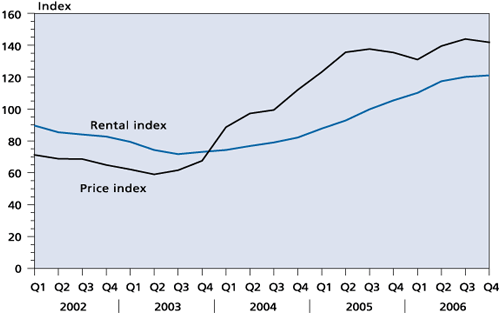 |
|
|
As for supply of new properties, completions of new private residential flats fell
slightly by 4 per cent to 16 600 units in 2006. Taking into account the number of
unsold units in completed projects and in to-be-completed projects, it is estimated
that the potential supply of new private residential flats will be in the region of
69 000 flats in the next three to four years. This is more than three times the average
number of primary flats sold during 2002-06. Compared with end-2005, the vacancy
rate of private residential property slipped to 5.9 per cent in 2006.
Regarding non-residential properties, completions in terms of internal floor area
surged by 97 per cent to 318 400 square metres in 2006, with the increase
concentrated in office and retail spaces. Yet as demand increased notably, the
vacancy rate fell across-the-board to 7.7 per cent for office space, 9.8 per cent for
retail space, 7.2 per cent for flatted factory space and 6.9 per cent for industrial-cum-office
space.
The number of property transactions, in terms of agreements for sale and
purchase of property registered with the Land Registry, declined by 20 per cent both
in volume and value in 2006. Transactions in residential property fell by 20 per cent
in volume and 26 per cent in value. The decrease occurred mainly in the first half of
2006 while the second half witnessed a modest rebound as sentiment improved as a
result of the pause in US interest rate increases which had been occurring since
August. As regards non-residential property, transactions fell markedly by 18 per
cent in 2006. But there was a marginal rise of one per cent in value, mainly due to
certain big-ticket transactions for office and industrial properties during the year
(Chart 15).
| Chart 15 |
| Sale and purchase agreements by |
| broad type of property |
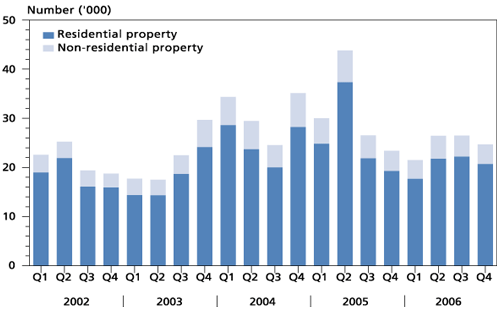 |
|
|
Price Movements
Consumer price inflation, though inching up during the first three quarters of
2006, remained moderate through to the end of 2006. The strong economic upturn,
coupled with the low inflation rate, provided a highly supportive marcroeconomic
environment for Hong Kong. The rapid increase in business investment over the past
year or so had contributed to notable productive improvement and capacity
expansion, which in turn helped to contain inflationary pressures. The steadier
increase in housing rents over the course of the year also helped. Externally, the
substantial easing in oil prices in the latter part of 2006 offset to some extent the
mild impacts of the weakening of the Hong Kong dollar alongside the US dollar and
the modest appreciation of renminbi on import prices. In overall terms, import prices
picked up slightly towards the end of the year. On a year-on-year basis, the increase
in the Composite Consumer Price Index inched up from 1.6 per cent in the first
quarter to 2 per cent and 2.3 per cent respectively in the second and third quarters,
before edging down to 2.1 per cent in the fourth quarter following the easing of oil
prices and a steadier increase in housing cost.
The GDP deflator, recorded a further slight decline of 0.4 per cent in 2006.
While export prices could rise only moderately because of the need to stay
competitive, import prices rose because of the rise in oil prices which later eased but
there was still a knock on effect from a weaker US dollar and the appreciation of
renminbi in the latter part of the year. Excluding the effect of the terms of trade, the
domestic demand deflator actually rose by 1.8 per cent in 2006, largely in sync with
consumer price inflation.
| Chart 16 |
| Main inflation indicators |
| (year-on-year rate of change) |
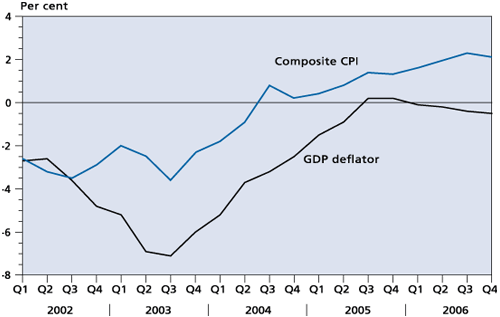 |
|
|
|